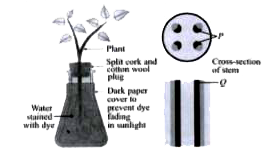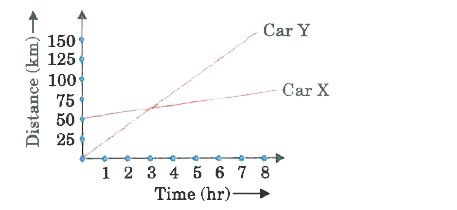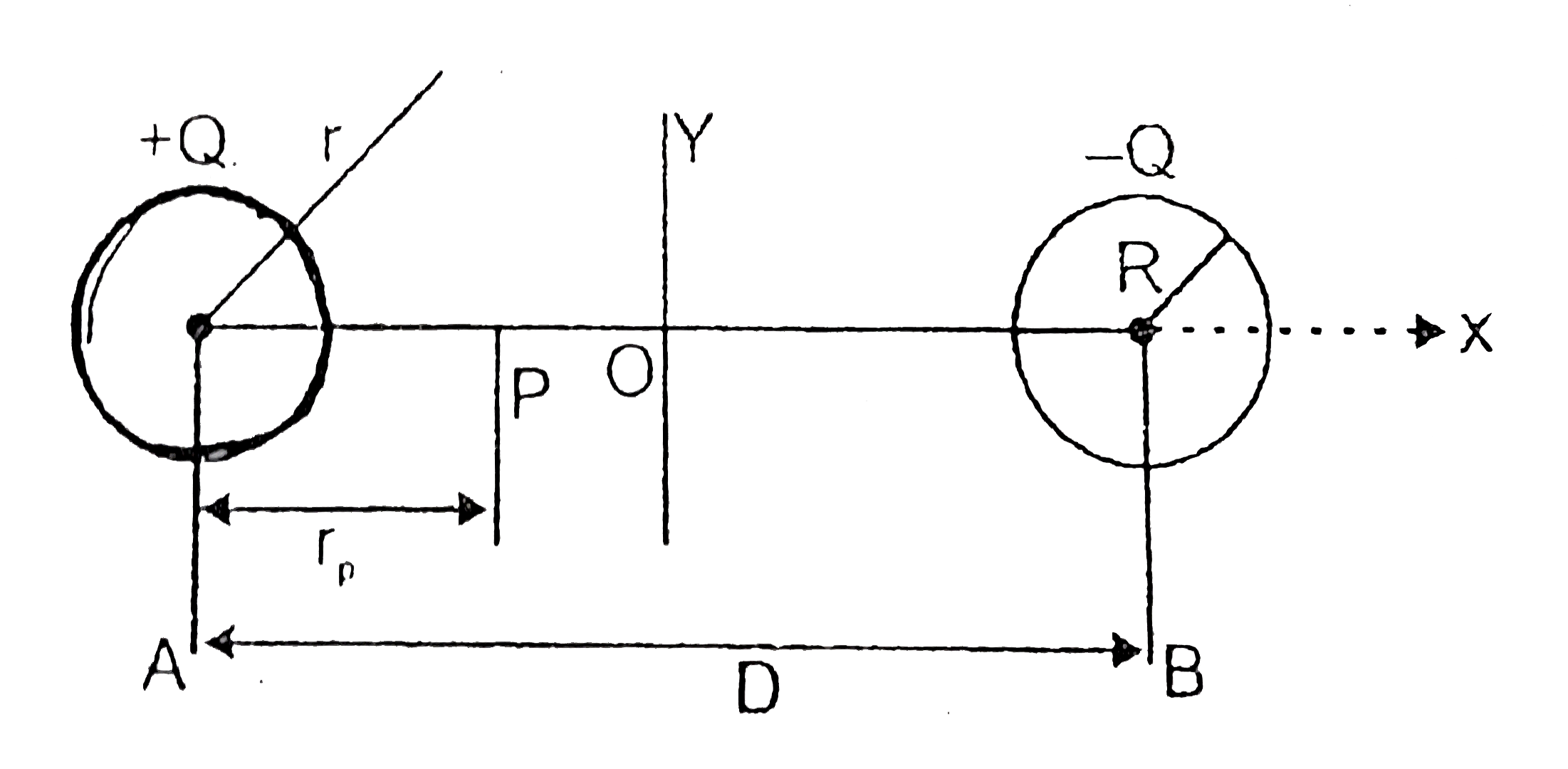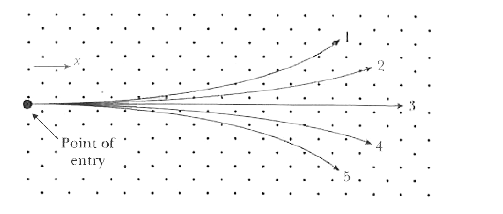The given figure shows an experiment in which a cut shoot of balsam plant is dipped in a blue coloured dye. After some time, sections from different parts of the stem starting from the tip region show the blue colour in the region P (marked in the section) which demonstrate the Q. P and stand for _____ .

P = Xylem, Q = Upward movement of water
P = Phloem, Q = Downward movement of food
P = Xylem, Q = Upward movement of food
P = Vascular bundle: Q = Conduction of water and food
The correct Answer is:B
Plants have special conducting structures called vascular bundles which consist of xylem and phloem. Xylem conducts water and dissolved nutrients upwards from roots to leaves, stem etc. Phloem conducts food prepared in leaves downwards to other organs as well as, upwards from food stored in the storage organs like stem tubers to other organs in need.
Topper's Solved these Questions
Similar Questions
The figure given below shows the distance-time graph of the two cars, which began their journey together, in the same direction, from different points of start.
(i) find the speed of car X and Car Y.
(ii) When and where will car Y catch car X?
 View Solution
View SolutionWhen the branches of a plant growing in the field are pulled towards the ground and a part of them is covered with moist soil (leaving the tips of the branches exposed above the ground), then after some time new roots develop from the parts of branches buried in the soil. On cutting these branches from the parent plant new plants are produced from the cut parts of branches which had developed roots.
(a) What is this method or propagation of plants knows as ?
(b) What type of branches should a plant have to be able to be propagated by this method?
(c) Name any two plants which are grown for their flower and propagated by this method
(d) Name any two plants which are grown for their fruits and propagated by this method
(e) Name of plant which gets propagated by this method naturally by forming runners (soft horizontal stem running above the ground)View Solution
Knowledge Check
- Question 1 - Select One

The figure shows two identical long straight metal wires, A and B placed parallel to z-axis the cross sectional radius of each wire is R and the separation of the two wires is D>>R. The electric potential at a perpendicular distance r>R from a long straight wire due to that wire is given by V=−kln(rR) where k is a positive constant. the wires carry charges +Q and −Q per unit length respectively. Then
Q. Consider a point P on the x-axis. The electric field at P is given by:A→E=(kD−rp−krp)ˆiB→E=k2(1rp+kD−rp)ˆiC→E=(krp+kD−rp)ˆiD→E=(krp−kD−rp)ˆi - Question 2 - Select One
The given figure shows five particles are shot from left into a region that contains a uniform electric field. The numbered lines shows the paths taken by the five particles. A negatively charged particle with a charge -3Q follows path 2 while it moves through this field. Do not consider any effects due to gravity.

Which path would be followed by a charge + 6Q ?Apath 1Bpath 5Cpath 2Dpath 4 - Question 3 - Select One
Read the following passage and answer the questions that follow :
Aesop prawns start life as colourless, almost transparent infants who drift with the tide. On reaching maturity, they drift inshore, reach out to grasp the first passing seaweed and, once established upon it, they proceed to colour themselves to blend with it. After a week, their colouring is complete and they are safe from the closest scrutiny. Should disaster strike and their chosen home be destroyed, they first try to find a new home with the same colour scheme as the first. If this proves impossible, they philosophically settle for a different coloured home and restart their own colouring process. A week zips past --- and they change colour to merge beautifully with their new homes once again. Aesop prawns also take on the colours of the day. Regularly at nightfall, they change to a deep transparent blue, reverting to their chosen house-colour as the sea lightens at dawn. Interestingly, the decision to adopt a particular colour is in no way an act of will on the part of the prawn. Scattered over its body surface are small pigment cells, each containing a central bag of colours (a reservoir of primary pigments: red, yellow and blue) with five branches extending from it. These pigment cells are influenced by the light that falls directly on them or enters through the prawn's eyes. Different coloured lights activate the hormones that control the flow of pigments. And after dark, red and yellow are withdrawn to make way for the nocturnal blue 'night suit' of the Aesop prawn. A system that provides the animal, at all times, with an enviable cloak of invisibility.
A word from the passage that means the same as 'night like' is .....ArevertingBcloakCnocturnalDpigment
Read the following passage and answer the questions that follow :
Aesop prawns start life as colourless, almost transparent infants who drift with the tide. On reaching maturity, they drift inshore, reach out to grasp the first passing seaweed and, once established upon it, they proceed to colour themselves to blend with it. After a week, their colouring is complete and they are safe from the closest scrutiny. Should disaster strike and their chosen home be destroyed, they first try to find a new home with the same colour scheme as the first. If this proves impossible, they philosophically settle for a different coloured home and restart their own colouring process. A week zips past --- and they change colour to merge beautifully with their new homes once again. Aesop prawns also take on the colours of the day. Regularly at nightfall, they change to a deep transparent blue, reverting to their chosen house-colour as the sea lightens at dawn. Interestingly, the decision to adopt a particular colour is in no way an act of will on the part of the prawn. Scattered over its body surface are small pigment cells, each containing a central bag of colours (a reservoir of primary pigments: red, yellow and blue) with five branches extending from it. These pigment cells are influenced by the light that falls directly on them or enters through the prawn's eyes. Different coloured lights activate the hormones that control the flow of pigments. And after dark, red and yellow are withdrawn to make way for the nocturnal blue 'night suit' of the Aesop prawn. A system that provides the animal, at all times, with an enviable cloak of invisibility.
Which one is the most appropriate opposite of ''INVISIBILE''View SolutionRead the following passage and answer the questions that follow :
Aesop prawns start life as colourless, almost transparent infants who drift with the tide. On reaching maturity, they drift inshore, reach out to grasp the first passing seaweed and, once established upon it, they proceed to colour themselves to blend with it. After a week, their colouring is complete and they are safe from the closest scrutiny. Should disaster strike and their chosen home be destroyed, they first try to find a new home with the same colour scheme as the first. If this proves impossible, they philosophically settle for a different coloured home and restart their own colouring process. A week zips past --- and they change colour to merge beautifully with their new homes once again. Aesop prawns also take on the colours of the day. Regularly at nightfall, they change to a deep transparent blue, reverting to their chosen house-colour as the sea lightens at dawn. Interestingly, the decision to adopt a particular colour is in no way an act of will on the part of the prawn. Scattered over its body surface are small pigment cells, each containing a central bag of colours (a reservoir of primary pigments: red, yellow and blue) with five branches extending from it. These pigment cells are influenced by the light that falls directly on them or enters through the prawn's eyes. Different coloured lights activate the hormones that control the flow of pigments. And after dark, red and yellow are withdrawn to make way for the nocturnal blue 'night suit' of the Aesop prawn. A system that provides the animal, at all times, with an enviable cloak of invisibility.
What are the colours of primary pigment in Aesop prawnsView SolutionRead the following passage and answer the questions that follow :
Aesop prawns start life as colourless, almost transparent infants who drift with the tide. On reaching maturity, they drift inshore, reach out to grasp the first passing seaweed and, once established upon it, they proceed to colour themselves to blend with it. After a week, their colouring is complete and they are safe from the closest scrutiny. Should disaster strike and their chosen home be destroyed, they first try to find a new home with the same colour scheme as the first. If this proves impossible, they philosophically settle for a different coloured home and restart their own colouring process. A week zips past --- and they change colour to merge beautifully with their new homes once again. Aesop prawns also take on the colours of the day. Regularly at nightfall, they change to a deep transparent blue, reverting to their chosen house-colour as the sea lightens at dawn. Interestingly, the decision to adopt a particular colour is in no way an act of will on the part of the prawn. Scattered over its body surface are small pigment cells, each containing a central bag of colours (a reservoir of primary pigments: red, yellow and blue) with five branches extending from it. These pigment cells are influenced by the light that falls directly on them or enters through the prawn's eyes. Different coloured lights activate the hormones that control the flow of pigments. And after dark, red and yellow are withdrawn to make way for the nocturnal blue 'night suit' of the Aesop prawn. A system that provides the animal, at all times, with an enviable cloak of invisibility.
Colour change of Aesop prawns is influenced byView SolutionRead the following passage and answer the questions that follow :
Aesop prawns start life as colourless, almost transparent infants who drift with the tide. On reaching maturity, they drift inshore, reach out to grasp the first passing seaweed and, once established upon it, they proceed to colour themselves to blend with it. After a week, their colouring is complete and they are safe from the closest scrutiny. Should disaster strike and their chosen home be destroyed, they first try to find a new home with the same colour scheme as the first. If this proves impossible, they philosophically settle for a different coloured home and restart their own colouring process. A week zips past --- and they change colour to merge beautifully with their new homes once again. Aesop prawns also take on the colours of the day. Regularly at nightfall, they change to a deep transparent blue, reverting to their chosen house-colour as the sea lightens at dawn. Interestingly, the decision to adopt a particular colour is in no way an act of will on the part of the prawn. Scattered over its body surface are small pigment cells, each containing a central bag of colours (a reservoir of primary pigments: red, yellow and blue) with five branches extending from it. These pigment cells are influenced by the light that falls directly on them or enters through the prawn's eyes. Different coloured lights activate the hormones that control the flow of pigments. And after dark, red and yellow are withdrawn to make way for the nocturnal blue 'night suit' of the Aesop prawn. A system that provides the animal, at all times, with an enviable cloak of invisibility.
The unique feature of Aesop prawns is that_View SolutionRead the following passage and answer the questions that follow :
Aesop prawns start life as colourless, almost transparent infants who drift with the tide. On reaching maturity, they drift inshore, reach out to grasp the first passing seaweed and, once established upon it, they proceed to colour themselves to blend with it. After a week, their colouring is complete and they are safe from the closest scrutiny. Should disaster strike and their chosen home be destroyed, they first try to find a new home with the same colour scheme as the first. If this proves impossible, they philosophically settle for a different coloured home and restart their own colouring process. A week zips past --- and they change colour to merge beautifully with their new homes once again. Aesop prawns also take on the colours of the day. Regularly at nightfall, they change to a deep transparent blue, reverting to their chosen house-colour as the sea lightens at dawn. Interestingly, the decision to adopt a particular colour is in no way an act of will on the part of the prawn. Scattered over its body surface are small pigment cells, each containing a central bag of colours (a reservoir of primary pigments: red, yellow and blue) with five branches extending from it. These pigment cells are influenced by the light that falls directly on them or enters through the prawn's eyes. Different coloured lights activate the hormones that control the flow of pigments. And after dark, red and yellow are withdrawn to make way for the nocturnal blue 'night suit' of the Aesop prawn. A system that provides the animal, at all times, with an enviable cloak of invisibility.
During the night Aesop prawnsView Solution
